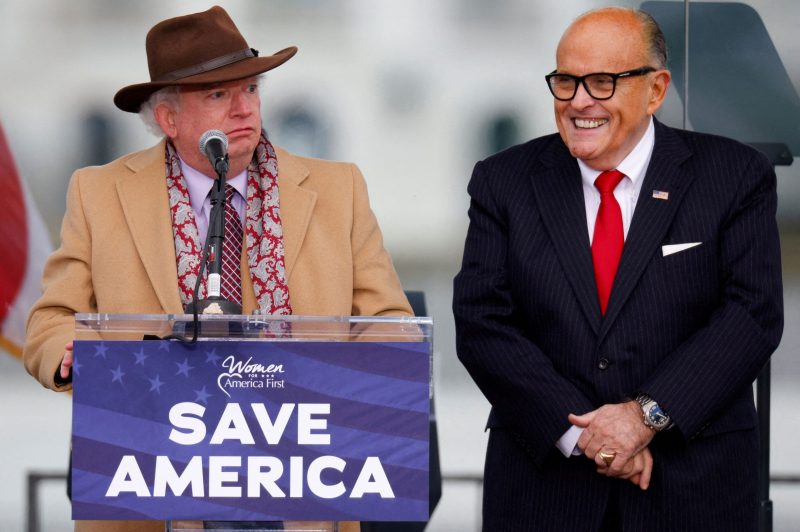Tom Klingenstein is a major donor to Republican political candidates and the chairman of the board of directors of the right-wing Claremont Institute. It is not entirely clear which of those roles spurred his recent interview with former Donald Trump attorney John Eastman, though it was probably both. Eastman’s facilitation of Trump’s efforts to overturn the results of the 2020 presidential election brought new disrepute on Claremont, an organization with which he’s long been associated, while any reframing of the Trump-Eastman effort couldn’t help but benefit the party.
That said, the effect of the conversation, published by Klingenstein in segments over the past few weeks, is not to make Eastman’s actions look more rational or well founded. (That may be the intended effect in part because Eastman is fighting disbarment in California.) Instead, it reinforces how his ongoing embrace of explicitly false claims led him to embrace what he himself described as the potential need to “alter or abolish the existing government.”
Klingenstein began the interview with an admission that Eastman was a friend, though he assured viewers he would “try not to serve up too many softballs.” But that was not the problem that ensued. Instead, it was that Klingenstein accepted Eastman’s often obviously false assertions as true without any pushback.
Consider a claim Eastman made about this newspaper. He was asked whether he felt the movie “2000 Mules,” by right-wing filmmaker Dinesh D’Souza, was credible. Eastman insisted it was, and that he liked the part of D’Souza’s book in which he rebutted those who pointed out the film’s flaws.
“My favorite example of this,” Eastman said, “is The Washington Post story that debunked it before the movie was even out.”
He is presumably referring to this May 11, 2022 story, written by me. The film was formally released later that month, but I’d already seen it, as D’Souza reached out in early April to offer to let me view it. On May 17, in fact, I published a lengthy conversation with D’Souza about the movie; at no point did he act bewildered that I’d somehow managed to view the film.
This example is very much to the point. The film is nonsense, centered on sweeping allegations made without evidence and depending on purported analysis from a thoroughly noncredible actor. It has been debunked in broad strokes and in specifics. But Eastman thinks it’s “very accurate.” He thinks, for example, that arrests made in relation to voter fraud in Arizona are attributable to D’Souza’s film when, in reality, they predated the 2020 election and D’Souza’s “analysis” by months. In fact, one arrest was cited in the film as an explanation for why one person allegedly committing fraud in the presidential race was wearing gloves. (D’Souza seemed baffled when I pointed out that this was more likely attributable to the pandemic.)
This is just one example. In his conversation with Klingenstein, Eastman presents a number of similarly debunked claims as accurate or somehow potentially accurate, from the long-debunked assertion that votes were hidden under a table in Fulton County, Ga., to the idea that there were more votes cast in Pennsylvania than there were registered voters. This, too, isn’t true — and the idea that it somehow could have been overlooked or dismissed for so long without any reaction should be obviously ridiculous to any objective observer.
But that is now how one should describe Eastman. After all, he filed a lawsuit more than a year ago in which he made a number of these same claims. He’s had months to disabuse himself of these erroneous notions, but has chosen not to. Klingenstein applied no pressure for him to do so.
“I’ve tried to be very careful on saying things that I could confirm or had fairly strong circumstantial evidence to support,” Eastman said at one point. Klingenstein’s response was not included in the video.
All of these assertions are important. Eastman’s entire argument for his actions after the 2020 election depends on the idea that he had evidence that the election might have been affected by fraud. He points to things like the lower rate of rejected mail-in ballots in Pennsylvania as suspicious, although that, too, has been explained: more attention paid to the process meant better-informed voters. What’s more, the rates dropped in a number of states, not just Pennsylvania. But Eastman assumes that this shift indicates fraud in the Keystone State and, applying some back-of-the-envelope math, that it made the difference for Joe Biden.
Importantly, he also thinks that similar calculations should have been enough for Pennsylvania’s legislature to reverse the results of the election in the state.
Eastman insisted to Klingenstein that on Jan. 6, 2021, he simply wanted Vice President Mike Pence to pause the counting of electoral votes for a week to 10 days so that legislatures could revisit results. They couldn’t concretely uncover fraud in such a time period, he admitted, but they could do some estimates about what happened.
“If it’s bigger than the outcome of the election, can we make an assessment, an educated guess about what the results of that election would have been?” he suggested the thought process might go. But even if they couldn’t, that they assumed illegality would shift “the actual burden of proof … back on those that are supporting the certification with the illegality, that the illegality didn’t affect the outcome.” And that could happen in a week.
In other words, Eastman is arguing that Pennsylvania could — despite the lack of evidence of fraud that had emerged after two months of relentless looking — have declared that maybe there was enough fraud to have affected the election and then simply flipped the results to Trump, demanding that Biden prove it didn’t happen.
This, in rhetorical terms, is known as “horse manure.”
Eastman apparently had few qualms about presenting Klingenstein with untrue claims, as when he suggested that he’d never advocated that Pence might simply reject electors out of hand. (A memo he wrote did exactly that and, at another point, he explained how that would affect the electoral math.) But it’s striking how flimsy the argumentation was that undergirded his explicit endorsement of retaining power.
He was not fazed by the idea that his plan would lead to angry protests in the streets, since “we give up much greater than the loss of a single election in a single officeholder if we succumb to mob rule and lose the rule of law in the process” — an ironic phrasing, certainly. Late in the conversation, though, his own anger at the political opposition came through.
“We are talking about whether we are going to, as a nation, completely repudiate every one of our founding principles, which is what the modern left wing, which is in control of the Democrat Party, believes — that we are the root of all evil in the world and we have to be eradicated,” he said. “This is an existential threat to the very survivability not just of our nation, but of the example that our nation properly understood provides to the world. That’s the stakes.”
2020, he continued, was “a stolen election that thwarts the will of the people trying to correct course and get back on a path that understands the significance and the nobility of America. And the American experiment is really at stake. And we ought to fight for it.”
Beyond his debunked fraud claims, Eastman also insisted that changes to vote-casting systems were unconstitutional and therefore marred the election results. He pointed to Pennsylvania’s changes as an example — though the chief justice of the state’s Supreme Court had opposed similar calls to throw out votes by late November 2020. After all, why should the good-faith will of the voters be denied if the process used to gather those ballots violated the rules? The court upheld those changes anyway, as Eastman should probably know.
But this is useful context for his claims. Even if Trump won every single swing state by 1,000 votes, he would still have lost the popular vote by millions.
“There’s actually a provision in the Declaration of Independence that says, you know, a people will suffer abuses while they remain sufferable. Or: tolerable. While they remain tolerable,” he said at one point. “But at some point, the abuses would become so intolerable that it is not only their right, but their duty to alter or abolish the existing government. So that’s the question. Have the abuses and the threat of abuses become so intolerable that we have to be willing to push back?”
Well, millions more Americans said that, no, they haven’t been, and tens of millions of others didn’t feel any urgency to cast a ballot. Eastman’s argument here is, in essence, that a minority that can’t win electoral support should have the right to “push back” against the majority. After all, the left “poses an existential threat to the very survivability” of the country, as he said! How could he not try to keep Trump in office?
As he put it to Klingenstein, there has been “an exponential increase” in the radicalization of the left over the last few years.
“You’re going to let 50-year-old men, naked, into teenage girls’ showers at public pools?” he said, echoing overheated but increasingly common right-wing rhetoric. “Or — or drag queens doing story hours to 6-year-olds?”
What choice did he have but to try to overthrow Biden’s election?




























